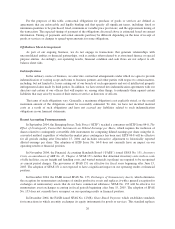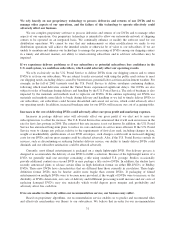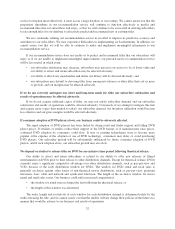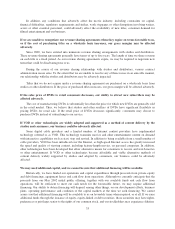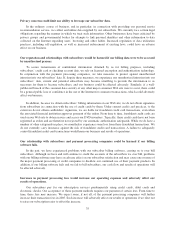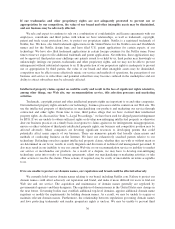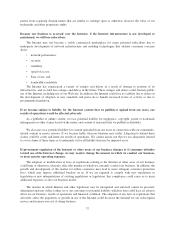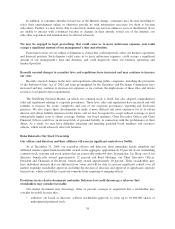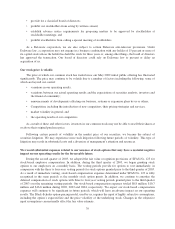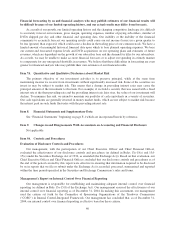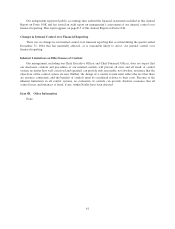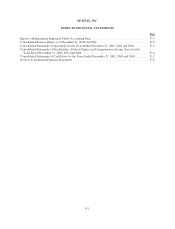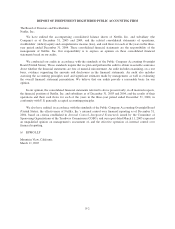NetFlix 2004 Annual Report Download - page 52
Download and view the complete annual report
Please find page 52 of the 2004 NetFlix annual report below. You can navigate through the pages in the report by either clicking on the pages listed below, or by using the keyword search tool below to find specific information within the annual report.If our trademarks and other proprietary rights are not adequately protected to prevent use or
appropriation by our competitors, the value of our brand and other intangible assets may be diminished,
and our business may be adversely affected.
We rely and expect to continue to rely on a combination of confidentiality and license agreements with our
employees, consultants and third parties with whom we have relationships, as well as trademark, copyright,
patent and trade secret protection laws, to protect our proprietary rights. Netflix is a registered trademark of
Netflix, Inc. We have also filed trademark applications in the United States for the Netflix.com and CineMatch
names and for the Netflix design logo, and have filed U.S. patent applications for certain aspects of our
technology. We have also filed trademark applications in certain foreign countries for the Netflix name. From
time to time we expect to file additional trademark and patent applications. Nevertheless, these applications may
not be approved, third parties may challenge any patents issued to or held by us, third parties may knowingly or
unknowingly infringe our patents, trademarks and other proprietary rights, and we may not be able to prevent
infringement without substantial expense to us. If the protection of our proprietary rights is inadequate to prevent
use or appropriation by third parties, the value of our brand and other intangible assets may be diminished,
competitors may be able to more effectively mimic our service and methods of operations, the perception of our
business and service to subscribers and potential subscribers may become confused in the marketplace and our
ability to attract subscribers may be adversely affected.
Intellectual property claims against us could be costly and result in the loss of significant rights related to,
among other things, our Web site, our recommendation service, title selection processes and marketing
activities.
Trademark, copyright, patent and other intellectual property rights are important to us and other companies.
Our intellectual property rights extend to our technology, business processes and the content on our Web site. We
use the intellectual property of third parties in merchandising our products and marketing our service through
contractual and other rights. From time to time, third parties allege that we have violated their intellectual
property rights. As discussed in “Item 3—Legal Proceedings,” we have been sued for alleged patent infringement
by BTG. If we are unable to obtain sufficient rights or develop non-infringing intellectual property or otherwise
alter our business practices on a timely basis in response to claims against us for infringement, misappropriation,
misuse or other violation of third party intellectual property rights, our business and competitive position may be
affected adversely. Many companies are devoting significant resources to developing patents that could
potentially affect many aspects of our business. There are numerous patents that broadly claim means and
methods of conducting business on the Internet. We have not exhaustively searched patents relative to our
technology. Defending ourselves against intellectual property claims, whether they are with or without merit or
are determined in our favor, results in costly litigation and diversion of technical and management personnel. It
also may result in our inability to use our current Web site or our recommendation service or inability to market
our service or merchandise our products. As a result of a dispute, we may have to develop non-infringing
technology, enter into royalty or licensing agreements, adjust our merchandizing or marketing activities or take
other actions to resolve the claims. These actions, if required, may be costly or unavailable on terms acceptable
to us.
If we are unable to protect our domain names, our reputation and brand could be affected adversely.
We currently hold various domain names relating to our brand, including Netflix.com. Failure to protect our
domain names could affect adversely our reputation and brand, and make it more difficult for users to find our
Web site and our service. The acquisition and maintenance of domain names generally are regulated by
governmental agencies and their designees. The regulation of domain names in the United States may change in
the near future. Governing bodies may establish additional top-level domains, appoint additional domain name
registrars or modify the requirements for holding domain names. As a result, we may be unable to acquire or
maintain relevant domain names. Furthermore, the relationship between regulations governing domain names
and laws protecting trademarks and similar proprietary rights is unclear. We may be unable to prevent third
36


